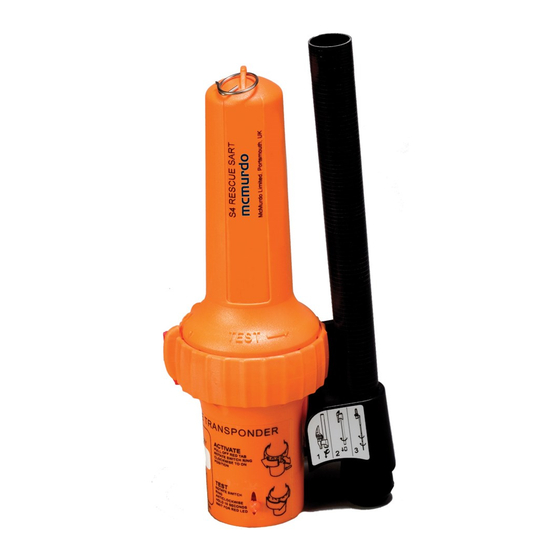Table of Contents
Advertisement
Advertisement
Table of Contents

Summary of Contents for mcmurdo S4 Rescue SART
- Page 1 RESCUE SART earch escue ransponder User Manual...
-
Page 2: Table Of Contents
CONTENTS Warnings..................1 General description..............2 SART principle of operation .............2 Installation .................4 SART General Assembly............5 Operating instructions ..............6 Self test facility ................7 Battery replacement ..............7 Technical description..............8 Function chart ................8 Dimensions ................9 Operation of marine radar for SART detection......10 Radar Range Scale .................. 10 SART Range Errors.................. -
Page 3: Warnings
Warnings • This SART is an emergency device for use only in situations of grave and imminent danger. • False alarms cost lives and money. Help to prevent them; understand how to activate and disable your equipment. • Read the complete manual before installing, testing or using the SART. -
Page 4: General Description
General description The SART (Search And Rescue Transponder) is designed for survivor location during search and rescue operations. CARRY-OFF SART Supplied as one integral unit. This is normally mounted in a bulkhead bracket (supplied) which is used to stow the unit on the mother vessel. On abandoning to a survival craft the SART can be carried in one hand off the stricken vessel and mounted through a port in the canopy of the survival craft using the telescopic pole. - Page 5 The SART operates by receiving a pulse from the search radar and sending back a series of pulses in response, which the radar will then display as if they were normal echoes. The first return pulse, if it sent back immediately, will appear in the same place on the PPI as a normal echo would have done.
-
Page 6: Installation
Installation The preferred mounting location is inside the vessel, and protected from the elements, usually on the ship’s bridge wing. The SAR should be mounted where it will not get in the way of day-to-day operations, but where it can readily be accessed near an emergency exit in the event it is needed. -
Page 7: Sart General Assembly
SART General Assembly Ring for internal liferaft mounting Mounting pole Radome Velcro strap Operating switch ring Battery pack Bulkhead Mounting Lanyard bracket (Velcro strap omitted for clarity) -
Page 8: Operating Instructions
Operating instructions Remove from bulkhead bracket: Release Velcro strap and lift SART from bracket To switch on: Pull the security tab away from the body of the SART Rotate the switch ring clockwise (ie to the left) to the ON position marked by “1”... -
Page 9: Self Test Facility
It is recommended that battery change should only be performed by an authorised McMurdo service agent, in order that a complete assessment and integrity check can be performed. The replacement battery kit is McMurdo part number 86-630. -
Page 10: Technical Description
Technical description A single switched antenna is used for both receive and transmit functions; the switch normally connects the antenna to the receiver circuit. In the standby state only the receiver portion of the SART is powered to reduce battery consumption to a minimum. -
Page 11: Dimensions
Dimensions... -
Page 12: Operation Of Marine Radar For Sart Detection
Operation of marine radar for SART detection Radar Range Scale When looking for a SART it is preferable to use a range scale between 6 and 12 nautical miles. This is because the spacing between the SART responses is about 0.6 nautical miles (1125 metres) and it is necessary to see a number of responses to distinguish the SART from other responses. -
Page 13: Anti-Clutter Sea Control
Anti-Clutter Sea Control For optimum range SART detection this control should be set to the minimum. Care should be exercised as targets in sea clutter may be obscured. Some radar sets have automatic/manual anti-clutter sea control facilities in which case the operator should switch to manual. -
Page 14: Technical Specification
Technical Specification FREQUENCY: 9.2GHz - 9.5GHz POLARIZATION: Horizontal SWEEP RATE: 5µs per 200MHz nominal RESPONSE 12 sweeps SIGNAL: FORM OF SWEEP: Forward: 7.5µs ± 1µs Reverse: 0.4µs ± 0.1µs PULSE EMISSION: 100µs nominal EIRP: >400mW (+26dBm) RX SENSITIVITY: Better than –50dBm (0.1 mW/m ) (Note 1) DURATION: 96 hours in standby condition followed by a minimum 8... -
Page 15: Declaration Of Conformity
Declaration of Conformity... - Page 16 Declaration of Conformity (page 2)
-
Page 17: Limited Product Warranty
(or part) in question free of charge, or at McMurdo Limited's sole discretion to refund to the buyer the price of the product (or a proportional part of the price). McMurdo Limited shall not be liable to a buyer who is not a consumer for any other loss or damage (whether indirect, special or consequential loss of profit or otherwise) costs, expenses or other claims for compensation which arise out of or in connection with this product. - Page 18 User Notes...
- Page 19 This page contains no other data...
- Page 20 McMurdo Ltd Silver Point Airport Service Road Portsmouth Hampshire United Kingdom PO3 5PB Telephone: Int +44 (0)23 9262 3900 Fax: Int +44 (0)23 9262 3998 sales@mcmurdo.co.uk www.mcmurdo.co.uk A member of Chemring Group PLC 86-920-001 Issue 1...






Need help?
Do you have a question about the S4 Rescue SART and is the answer not in the manual?
Questions and answers